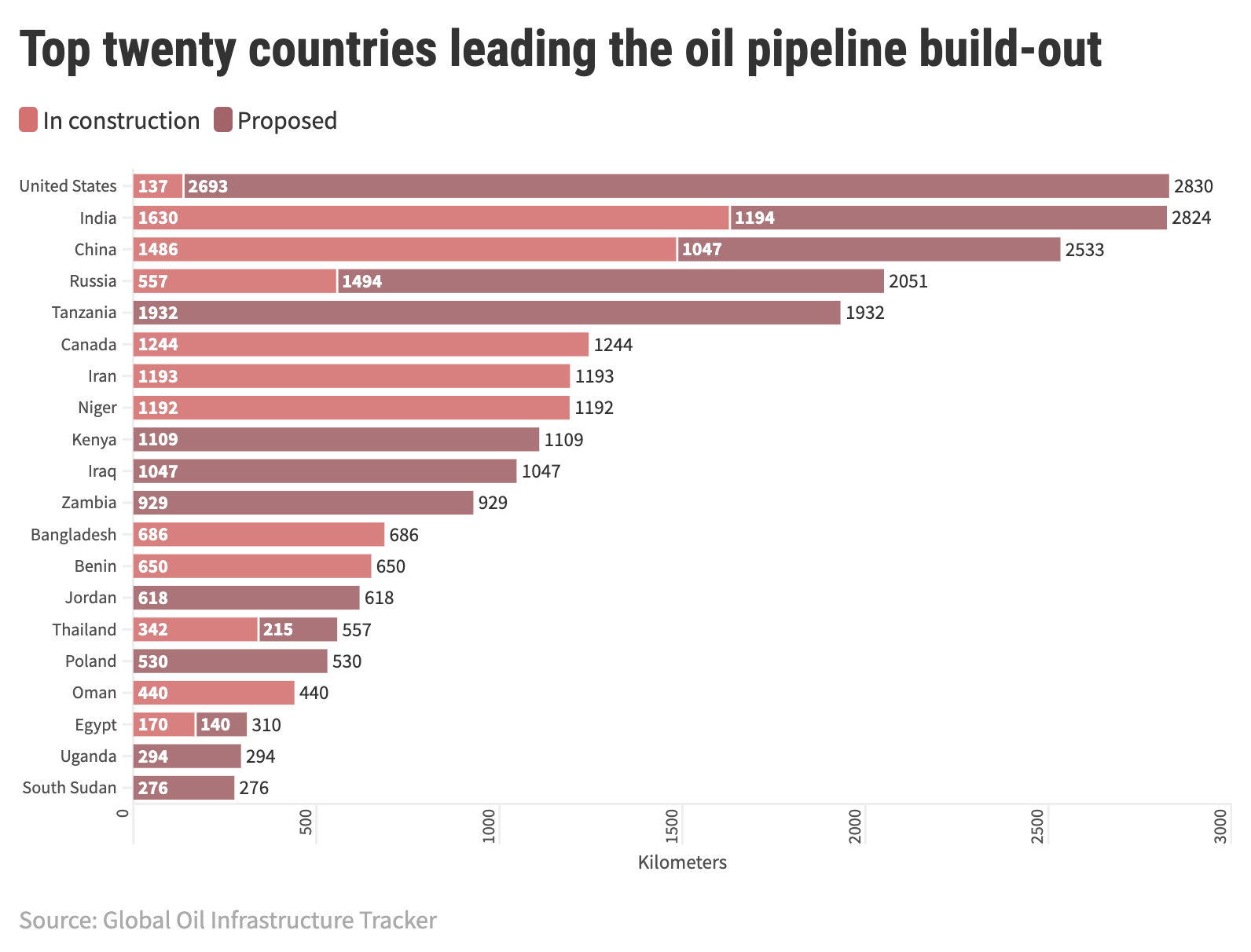San Francisco CA – Buoyed by record profits, the oil industry is developing 24,166 km of new oil pipelines—enough to stretch nearly two-thirds around Earth—10,351 km of which are already under construction, according to new data from Global Energy Monitor (GEM).
The oil pipeline build-out is dramatically at odds with efforts to limit global warming to 1.5 ºC or 2.0 ºC and represents a stranded asset risk of up to USD 75.4 billion for project developers, GEM estimates, as the world increasingly transitions from oil and gas to renewables.
Key findings:
- The United States is tied for the most new pipeline capacity by length under development. The US has 2,829 km costing an estimated USD 7.9 billion being developed, the majority of which is associated with the Permian Basin.
- Facing boycotts by the EU and US over its war on Ukraine, Russia is developing 2,051 km of new pipelines costing an estimated USD 4.0 billion, with an eye to replacing these lost exports with new exports to India and China. GEM’s data finds several European countries still invested in Russian oil projects, despite these boycotts: the 1,600 km proposed Vostok Oil Pipeline counts the Dutch MME and Swiss trading company Vitol among its owners, and shareholders in the Caspian Pipeline include subsidiaries of US-based ExxonMobil and Shell, UK-based BP and BG Overseas Holdings Ltd, and Italy-based Eni SpA
- Tied for first with the US is India with 2,824 km of new oil pipelines in development, costing an estimated USD 4.0 billion. The third-biggest developer is China 2,533 km costing an estimated USD 4.2 billion.
- Regionally, Sub-Saharan Africa leads the world in planned development, with 1,950 km of oil pipelines under construction and an additional 4,540 km proposed.
- Poor disclosure of barrels-per-day (bpd) capacity is hampering attempts to measure the environmental impact of new oil pipelines. For pipelines for which GEM has capacity data–66% of the total in its database–pipelines under construction would add about 8.3 million barrels per day (bpd) of crude oil transmission capacity, and projects that are in pre-construction would add an additional 21.8 million bpd. Together these additional capacities would generate 4.61 billion tonnes of CO2 annually.
“This report shows that some of the world’s biggest consumers of fossil fuels are doubling down on oil, even as the climate crisis intensifies,” said Baird Langenbrunner, a Researcher for GEM. “And for governments endorsing these new pipelines, the report shows an almost deliberate failure to meet climate goals.”
Contacts
Baird Langenbrunner, Project Manager, Global Oil Infrastructure Tracker

About the Global Oil Infrastructure Tracker
The Global Oil Infrastructure Tracker catalogs midstream crude oil and natural gas liquids (NGL) transmission pipelines globally, including information about status, route, capacity, and capital costs. The database is distributed freely under a Creative Commons CC BY-NC-SA 4.0 license, and individual projects are discussed on GEM.wiki pages. The interactive tracker map can be used to visualize and learn more about projects.
###
Global Energy Monitor is a nonprofit research organization developing information on energy projects worldwide. Through its Global Solar Power Tracker and Global Solar Power Tracker projects, Global Energy Monitor provides annual updates on wind and solar powered facilities. Global Energy Monitor data is used by the International Energy Agency (IEA), the OECD Environment Directorate, UN Environment Programme, U.S. Treasury Department, and World Bank.
